 Last additions - KYOTO 京都府 Last additions - KYOTO 京都府 |

Oct 07, 2018
|
|

Oct 07, 2018
|
|

Oct 07, 2018
|
|

Tsutenkyo (通天橋)Oct 07, 2018
|
|

That's the bridge where everybody is going. Tsutenkyo (通天橋)Oct 07, 2018
|
|

Tofukuji Temple, KyotoOct 07, 2018
|
|

Oct 07, 2018
|
|

Oct 07, 2018
|
|

Oct 07, 2018
|
|

Oct 07, 2018
|
|

Oct 07, 2018
|
|

Oct 07, 2018
|
|

Oct 07, 2018
|
|

Oct 07, 2018
|
|

Oct 07, 2018
|
|

Oct 07, 2018
|
|

The trees are very well placed and very photogenic.Oct 07, 2018
|
|

Oct 07, 2018
|
|

Longer line to get to Tsutenkyo Bridge. But we enjoyed the colors along the way. The line went along fast enough.Oct 07, 2018
|
|

There was a line to get into the temple (¥400 admission).\\Oct 07, 2018
|
|

Oct 07, 2018
|
|

This is the symbol of Tofukuji temple, a bridge named Tsutenkyo (通天橋) that goes across this mass of red Japanese maple trees. You see this photo in all the Kyoto travel brochures.Oct 07, 2018
|
|

Long line to enter Tofukuji, but it progressed quickly enough.Oct 07, 2018
|
|

Tofukuji is a Zen Buddhist temple famous for red maple leaves. Quite spectacular and photogenic landscapes. One of the five great Zen temples of Kyoto. Tofukuji temple is the easiest way to see autumn leaves in Kyoto. From Kyoto Station, it's only one train stop (JR Nara Line) away (get off at Tofukuji Station and walk 10 min.). But the trains get sardine-packed in the morning. Expect large crowds during late Nov.Oct 07, 2018
|
|

Oct 07, 2018
|
|
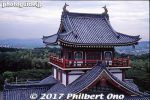
Oct 02, 2018
|
|
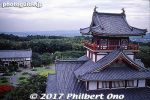
Oct 02, 2018
|
|

View from Fushimi Castle.Oct 02, 2018
|
|

Oct 02, 2018
|
|
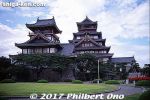
Reconstruction of Fushimi Castle when it was still open to the public from 1964 to 2003. It was a museum about Toyotomi Hideyoshi who built the original Fushimi-Momoyama Castle. This was the main attraction of a small theme park called "Castle Lan.&qOct 02, 2018
|
|

Made of ferroconcrete.Oct 02, 2018
|
|

Jul 20, 2017
|
|

Jul 20, 2017
|
|

Jul 20, 2017
|
|

Jul 20, 2017
|
|

Jul 20, 2017
|
|

Jul 20, 2017
|
|

Fog thereby forms over the tea plants to shade them from the strong sunlight. Tea plants also grow best in well-drained soil, hence the tea plants on sloping land.Jul 20, 2017
|
|

This is the Ishitera area of Wazuka (pop. 4,226 as of Feb. 2016), a small town in southern Kyoto with about 301 Uji tea farmers.Jul 20, 2017
|
|

Blessed with rolling hills and clear streams, Wazuka produces about 40 percent of Kyoto's Uji tea production. Wazuka is most suited for tea cultivation because there is a large temperature difference between night and day.Jul 20, 2017
|
|

Hoiro, a hot drying plate for kneading tea buds to make sencha. It produced excellent color, aroma, and taste of sencha tea. He taught his technique to anybody who flocked to his home. It spread nationwide and his basic technique is still in wide use today. Jul 20, 2017
|
|

Grid underneath the hoiro.Jul 20, 2017
|
|

Jul 20, 2017
|
|

Jul 20, 2017
|
|

Inside Nagatani Soen's birthplace home (replica). There's a video explaining the process.Jul 20, 2017
|
|

Jul 20, 2017
|
|

Nagatani Soen's birthplace home (replica).Jul 20, 2017
|
|

His birthplace house is a replica in Yuyadani, Ujitawara. Open only on Sat. and Sun. Jul 20, 2017
|
|

Nagatani Soen's birthplace is not easily accessible unless you have a car.Jul 20, 2017
|
|

In 1738, Nagatani Soen basically invented sencha green tea by using a kneading process for young tea leaves. He used a hot drying plate called hoiro to knead the steamed tea buds by hand to dry them. The process is called aosei sencha seiho. Jul 20, 2017
|
|

In the end, we could even eat the used tea leaves which tasted like spinach maybe.Jul 20, 2017
|
|

Another cup.Jul 20, 2017
|
|

First cup of tea.Jul 20, 2017
|
|

Our tea-making kit. Jul 20, 2017
|
|

Our instructor (on the left).Jul 20, 2017
|
|

Hot water thermos.Jul 20, 2017
|
|

Our tea-making kit. Everything is provided.Jul 20, 2017
|
|

Inside Takumi no Yakata. Like a workshop or classroom for making tea.Jul 20, 2017
|
|
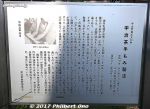
Jul 20, 2017
|
|

Takumi no Yakata was where we could make our own tea (with careful instructions).Jul 20, 2017
|
|

Entrance to Takumi no Yakata (匠の館).Jul 20, 2017
|
|

Tourists visiting Byodo-in temple can also experience and taste Uji tea at nearby Takumi no Yakata (匠の館).Jul 20, 2017
|
|

Small grinder.Jul 20, 2017
|
|

Grinder faceJul 20, 2017
|
|

Sample grinder. The dried tea leaves are fed through a funnel to the grinding stones.Jul 20, 2017
|
|

Matcha tea leaves to be ground.Jul 20, 2017
|
|

Stone grinders grinding matcha tea leaves into fine matcha power at Horii Shichimeien's tea factory. Watching these grinders was mesmerizing..Jul 20, 2017
|
|

Stone grinders grinding matcha (tencha) tea leaves into fine matcha power at Horii Shichimeien's tea factory.Jul 20, 2017
|
|

It was a room full of stone grinders grinding matcha tea leaves into fine matcha power.Jul 20, 2017
|
|

Inside Horii Shichimeien's tea factory.Jul 20, 2017
|
|

We then got to see Horii Shichimeien's matcha tea factory. (Note that this is not open to normal tourists.)Jul 20, 2017
|
|

Mrs. Horii prepares a different kind of tea.Jul 20, 2017
|
|

Jul 20, 2017
|
|
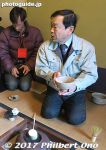
Jul 20, 2017
|
|

Matcha tea and a confection. The tea was outstanding. It had a malty, matcha taste. Pretty thick. The aftertaste was interesting.Jul 20, 2017
|
|

Behind Horii Shichimeien's tea shop is a small tea house for tea ceremony. Mr. Horii kindly prepares his finest marcha tea for us.Jul 20, 2017
|
|

Some of the finest Uji matcha powder at Horii Shichimeien.Jul 20, 2017
|
|

Some of the finest Uji matcha powder at Horii Shichimeien.Jul 20, 2017
|
|

Jul 20, 2017
|
|

Jul 20, 2017
|
|

Near their tea farm, Horii Shichimeien also has a tea shop selling some of Japan's finest tea.Jul 20, 2017
|
|

Jul 20, 2017
|
|

Only part of the original Okunoyama Chaen remains as a tea field. The original Okunoyama tea field was larger. Notice the shade.Jul 20, 2017
|
|

In 15th century, Ashikaga Yoshimitsu and Yoshinaga loved Uji tea so much that they designated seven tea fields as the Seven Reknown Tea Fields. Today only Okunoyama Chaen remains.Jul 20, 2017
|
|

Chotaro Horii is the 6th-generation owner/operator of Horii Shichimeien which was originally Okunoyama Chaen (奥ノ山茶園), one of Uji's Seven Reknown Tea Fields (七名園).Jul 20, 2017
|
|

Jul 20, 2017
|
|

Jul 20, 2017
|
|

Jul 20, 2017
|
|

Jul 20, 2017
|
|

Jul 20, 2017
|
|

Jul 20, 2017
|
|

Jul 20, 2017
|
|

We were served tea.Jul 20, 2017
|
|

Jul 20, 2017
|
|

We could go inside this building.Jul 20, 2017
|
|

Jul 20, 2017
|
|

Jul 20, 2017
|
|

Jul 20, 2017
|
|

Jul 20, 2017
|
|

Jul 20, 2017
|
|

Jul 20, 2017
|
|

Jul 20, 2017
|
|

Jul 20, 2017
|
|

Jul 20, 2017
|
|

Jul 20, 2017
|
|

Jul 20, 2017
|
|

Jul 20, 2017
|
|

Jul 20, 2017
|
|

Jul 20, 2017
|
|

Jul 20, 2017
|
|

Jul 20, 2017
|
|

Jul 20, 2017
|
|

Jul 20, 2017
|
|

Jul 20, 2017
|
|

Kamikoma is a neighborhood of about 40 Japanese tea wholesalers. There is some traditional buildings, and only one or two buildings where the public can enter.Jul 20, 2017
|
|

Jul 20, 2017
|
|

Slow Life CafeJul 20, 2017
|
|

Might be the priest's residence.Jul 20, 2017
|
|

Jul 20, 2017
|
|

Jul 20, 2017
|
|

Lesser shrines.Jul 20, 2017
|
|

Jul 20, 2017
|
|

Jul 20, 2017
|
|

First floor of pagoda.Jul 20, 2017
|
|

Kaijusenji's five-story pagoda is a National Treasure.Jul 20, 2017
|
|

Jul 20, 2017
|
|

Kaijusenji's five-story pagoda is a National Treasure, built in 1214.Jul 20, 2017
|
|

Jul 20, 2017
|
|

Jul 20, 2017
|
|

Our volunteer tour guide.Jul 20, 2017
|
|

Built in the Nara Period, Kaijusenji is a Chisan-ha Shingon Buddhist temple. It worships an eleven-face Kannon statue. Jul 20, 2017
|
|

Present main temple hall built in 1884.Jul 20, 2017
|
|

Pine treeJul 17, 2017
|
|

Very unusual thatched roof home near Manpukuji.Jul 17, 2017
|
|

Fire hydrant manhole. Near Manpukuji, Uji, Kyoto.Jul 17, 2017
|
|

"Curios" is an archaic term from the Meiji Period.Jul 17, 2017
|
|
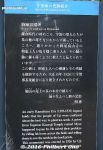
About Koma no Ashikage-en Monument. According to legend, local people in Uji pondered over how to sow the seeds to grow tea.It was then Priest Myoe (明恵), from the Kegon-shu Buddhist Sect, came on horseback and trotted on the field saying, "Plant the seeds in my horse's hoof prints." This monument was built by Uji tea growers in 1926 to express their appreciation to Myoe.Jul 17, 2017
|
|

Koma no Ashikage-en Monument in front of the entrance to Manpukuji temple. This can be roughly translated as "Hoof Print Field Monument." 駒蹄影園跡碑This monument is part of the Japan Heritage designation for Uji tea history.Jul 17, 2017
|
|

Marijuana leaf (or maybe maple leaf) design on this street gutter cover near Manpukuji. Probably hemp leaves, commonly used for making cloth.Jul 17, 2017
|
|
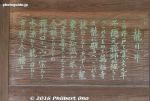
Jul 17, 2017
|
|

WellJul 17, 2017
|
|

Buddhist picture print too.Jul 17, 2017
|
|

Sample printings.Jul 17, 2017
|
|

Woodblock for printing Buddhist scripture. Looks very worn out.Jul 17, 2017
|
|

Jul 17, 2017
|
|

Jul 17, 2017
|
|

Tetsugen Doko (1630-1682), one of Ingen's Japanese disciples, started the project to make these printing blocks still used today.Jul 17, 2017
|
|

Manpukuji also has a subtemple and treasure house called Hozoin (宝蔵院) noted for storing tens of thousands of woodblocks that are still used for printing Buddhist scriptures.Jul 17, 2017
|
|

Entrance to Hozoin.Jul 17, 2017
|
|

Jul 17, 2017
|
|

Jul 17, 2017
|
|

Jul 17, 2017
|
|

Jul 17, 2017
|
|

Manpukuji also has a subtemple and treasure house called Hozoin (宝蔵院) noted for storing tens of thousands of woodblocks used for printing Buddhist scriptures.Jul 17, 2017
|
|

Lotus in a pot at Manpukuji temple.Jul 17, 2017
|
|

Little pine cones at Manpukuji.Jul 17, 2017
|
|

Dessert. One of the best meals I ever had in Japan. Advance reservations are required. It's not a walk-in restaurant. More info photos in Japanese: https://www.obakusan.or.jp/eat/Jul 17, 2017
|
|

Rice was finally served at the end with pickles.Jul 17, 2017
|
|

Jul 17, 2017
|
|

Jul 17, 2017
|
|

Fucha ryori has no fish nor meat.Jul 17, 2017
|
|

Fucha ryori became very popular after it was first introduced in Japan. No wonder. It looks exotic and tastes absolutely delicious. Salad.Jul 17, 2017
|
|

Appetizers of our full-course, Chinese-style religious vegetarian cuisine at Icho-an. This plate was for four people. Very different, very colorful, and such a unique taste and deliciousness that I've never had before.Fucha ryori is healthy too. Well worth the ¥5,000 which I first thought was quite pricey for a religious meal with no meat. Got stuffed and we could take home some food too.Jul 17, 2017
|
|

Inside Icho-an. We could immediately tell that it was Chinese since the food was served on a turntable (Lazy Susan) which you can see in the photo.(This photo was taken after we finished lunch.)Jul 17, 2017
|
|

Icho-an restaurant serves Chinese-style shojin-ryori (religious vegetarian cuisine) called fucha-ryori (普茶料理). This is another thing about Manpukuji. The sect's founder Ingen helped to spread Chinese cuisine in Japan from the 17th c.Jul 17, 2017
|
|

Near the Sanmon Gate is this entrance to Icho-an restaurant. 銀杏庵Jul 17, 2017
|
|

A simple bento (box lunch) fucha ryori at Manpukuji temple, Uji, Kyoto 普茶料理Jul 17, 2017
|
|

"Obaku-san Fucha Ryori" bento-type (box lunch) fucha ryori for our large tour group. It costs around ¥3,000.Jul 17, 2017
|
|

On my second visit to Manpukuji, I went with a group of foreigners and had lunch at the temple's restaurant Oryokaku (黄龍閣) serving Chinese-style shojin-ryori (religious vegetarian cuisine) called fucha-ryori (普茶料理).Jul 17, 2017
|
|

Plum blossoms.Jul 17, 2017
|
|

Women cleaning the sliding lattice doors before repapering.Jul 17, 2017
|
|

Prayer tablets (ema)Jul 17, 2017
|
|

About the Bell TowerJul 17, 2017
|
|

Bell tower (Important Cultural Property)Jul 17, 2017
|
|

伽藍堂Jul 17, 2017
|
|

伽藍堂 (Important Cultural Property)Jul 17, 2017
|
|

Jul 17, 2017
|
|

Manpukuji's famous wooden fish board used like a gong to indicate the time. 魚梆Jul 17, 2017
|
|

Manpukuji's famous fish board. 魚梆Jul 17, 2017
|
|

Jul 17, 2017
|
|

About Hatto Hall. Jul 17, 2017
|
|

Hatto Hall's bell-shaped window.Jul 17, 2017
|
|

Jul 17, 2017
|
|

Behind the Daiohoden Hall is Hatto Hall (Important Cultural Property) where Buddhist lectures are held. 法堂(はっとう)Jul 17, 2017
|
|

Rear view of Daiohoden Hall.Jul 17, 2017
|
|

Rear view of Daiohoden Hall.Jul 17, 2017
|
|

Jul 17, 2017
|
|

Jul 17, 2017
|
|

Jul 17, 2017
|
|

Jul 17, 2017
|
|

Jul 17, 2017
|
|

Jul 17, 2017
|
|

Each arhat has a name.Jul 17, 2017
|
|

Daiohoden Hall also has statues of the Eighteen Arhats. 十八羅漢像They are the original followers of the Buddha who have reached the state of Nirvana and are free of worldly desires. Jul 17, 2017
|
|

These mats on the floor are not for sitting. The priests stand behind the mats and chant.Jul 17, 2017
|
|

Side view of the Shaka Nyorai.Jul 17, 2017
|
|

Chinese wooden fish drum for beating during prayers.Jul 17, 2017
|
|

Jul 17, 2017
|
|

Shaka Nyorai or Gautama Buddha, founder of Buddhism. 釈迦如来座像Jul 17, 2017
|
|

Jul 17, 2017
|
|

Altar inside Daiohoden Hall, Manpukuji's main temple. It worships a sitting Shaka Nyorai or Gautama Buddha. 大雄寶殿(だうおうほうでん)Jul 17, 2017
|
|

In front of Daiohoden Hall.Jul 17, 2017
|
|

Daiohoden Hall entrance.Jul 17, 2017
|
|

Round window at Daiohoden Hall.Jul 17, 2017
|
|

Chinese-style incense burner.Jul 17, 2017
|
|

Daiohoden Hall (Important Cultural Property), Manpukuji's main temple. 大雄寶殿(だうおうほうでん)Jul 17, 2017
|
|

About Daiohoden Hall.Jul 17, 2017
|
|

Daiohoden Hall (Important Cultural Property), Manpukuji's main worship hall or temple. 大雄寶殿(だうおうほうでん)Jul 17, 2017
|
|

Jul 17, 2017
|
|

Daiohoden Hall roof.Jul 17, 2017
|
|

Jul 17, 2017
|
|

Corridor to Daiohoden Hall.Jul 17, 2017
|
|

Jul 17, 2017
|
|

Jul 17, 2017
|
|

Jul 17, 2017
|
|

Jul 17, 2017
|
|

Jul 17, 2017
|
|

Jul 17, 2017
|
|

Jul 17, 2017
|
|

Jul 17, 2017
|
|

Jul 17, 2017
|
|

Jul 17, 2017
|
|

Jul 17, 2017
|
|

Statue behind the Hotei statue.Jul 17, 2017
|
|

Our Manpukuji priest guide spoke through our interpreter.Jul 17, 2017
|
|
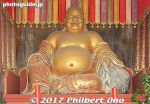
Inside Manpukuji's Tennoden Hall is Hotei, one of the Seven Gods of Good Fortune. 天王殿(てんのうでん)、弥勒菩薩(布袋)Jul 17, 2017
|
|

Our Manpukuji priest guide admits his resemblance to Hotei and kindly posed next to it.Jul 17, 2017
|
|

Inside the Tennoden Hall is Hotei, one of the Seven Gods of Good Fortune. 天王殿(てんのうでん)、弥勒菩薩(布袋)Jul 17, 2017
|
|

Jul 17, 2017
|
|

Tennoden Hall (Important Cultural Property). 天王殿(てんのうでん)Jul 17, 2017
|
|

Jul 17, 2017
|
|

Manpukuji temple bell in a corridor.Jul 17, 2017
|
|

Manpukuji temple bell in a corridor.Jul 17, 2017
|
|

Manpukuji corridor lanterns.Jul 17, 2017
|
|

Jul 17, 2017
|
|

石碑Jul 17, 2017
|
|

寿塔Jul 17, 2017
|
|

Manpukuji has a lot of covered corridors linking the major buildings.Jul 17, 2017
|
|

The big Sanmon Gate in the background.Jul 17, 2017
|
|

Kaizan-do HallJul 17, 2017
|
|

Altar inside the Kaizan-do Hall.Jul 17, 2017
|
|

Jul 17, 2017
|
|

Chinese design on the railing. Temple buildings are in Ming-style. Many buildings are Important Cultural Properties, but no National Treasures. 卍崩しのデザインJul 17, 2017
|
|

Chinese-style architecture is obvious with the roof corners curling upward.Jul 17, 2017
|
|

Manpukuji's Kaizan-do Hall (Important Cultural Property) where sect founder Yinyuan Longqi (Ingen) is worshipped. 開山堂(かいさんどう)Jul 17, 2017
|
|

Very fine roof.Jul 17, 2017
|
|

Karahafu roof gableJul 17, 2017
|
|

Karahafu roof gableJul 17, 2017
|
|

Jul 17, 2017
|
|

Before going to Tennoden Hall, we turned left to this small gate leading to Kaizan-do Hall.Jul 17, 2017
|
|

Jul 17, 2017
|
|

From Sanmon Gate, path to Tennoden Hall. The path is modeled after dragon scales.Jul 17, 2017
|
|
| 2715 files on 11 page(s) |
 |
 |
4 |  |
 |
|